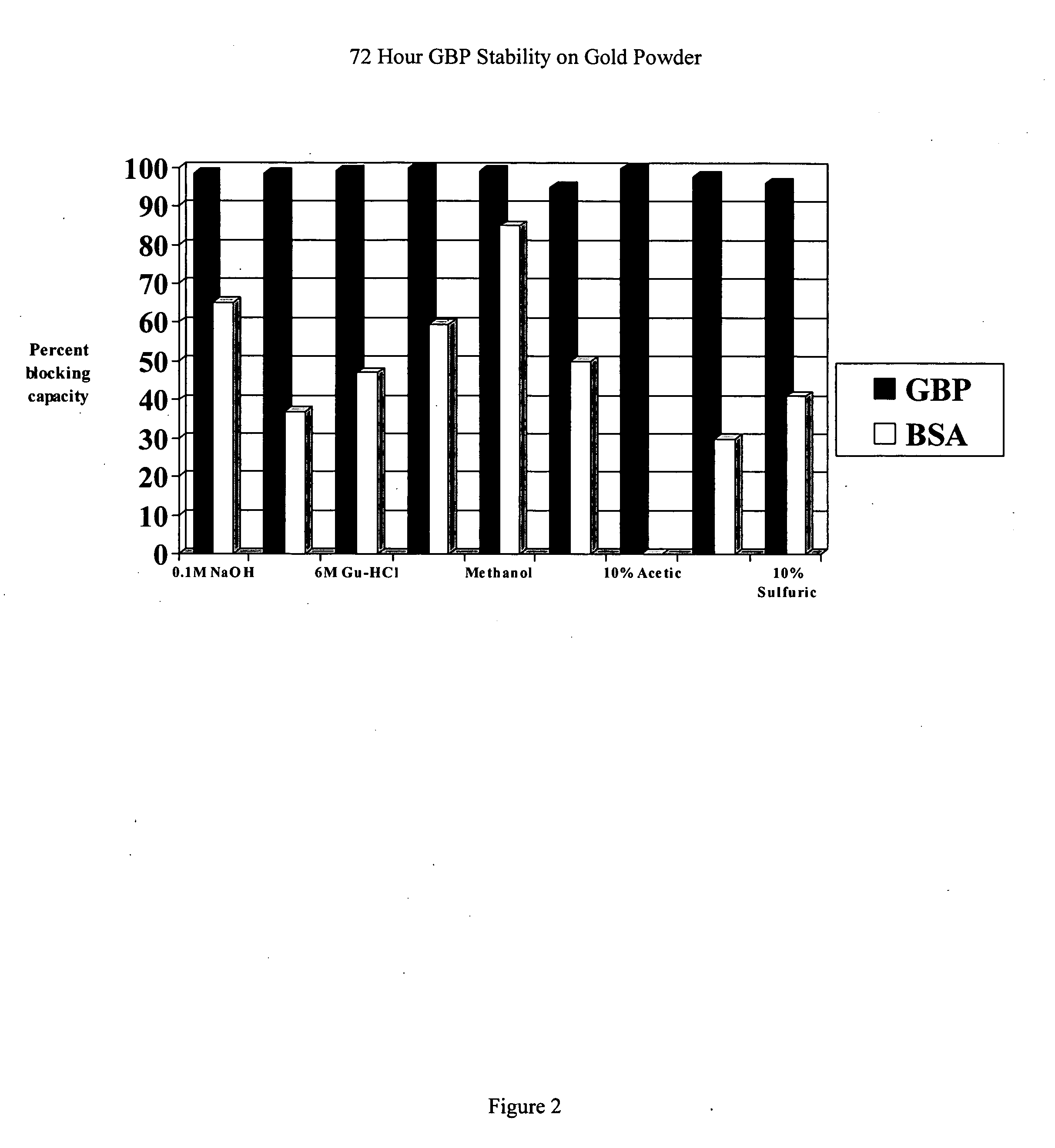Gold surfaces coated with a thermostable chemically resistant polypeptide layer and applications thereof
a polypeptide layer and thermostable technology, applied in the field of biomolecular coatings, can solve the problems of limiting the ability to prepare functional surfaces, affecting the application of biomolecular coatings, and wasting resources, so as to reduce the number of potential applications, reduce the number of surface interactions, and maximize the effect of surface interaction
- Summary
- Abstract
- Description
- Claims
- Application Information
AI Technical Summary
Benefits of technology
Problems solved by technology
Method used
Image
Examples
example 1
[0156] Plasmid Design for Expression of GBP Fusion Proteins
[0157] Recombinant fusion proteins are produced by expression of plasmid constructs encoding the protein of interest fused with the GBP. The plasmid constructs include a selectable marker including but not limited to ampicillin resistance, kanamycin resistance, neomycin resistance or other selectable markers. Transcription of the GBP fusion protein is driven by a regulatable promoter specific for expression in bacteria, yeast, insect cells or mammalian cells. The construct includes a leader sequence for expression in the periplasmic space, for secretion in the media, or for secretion in yeast or mammalian cells or insect cells. Plasmid constructs include multiple cloning sites for insertion of protein sequences in frame with respect to the GBP polypeptide. The GBP sequence can be inserted at the amino-terminal or C-terminal end of fusion partners or inserted between the coding sequence of one or more fusion partners. More t...
example 2
[0171] Purification of GBP-Fusion Proteins
[0172] Larger cultures were grown to produce sufficient fusion proteins for purification and characterization. To extract proteins under “native” conditions for subsequent purification, the bacteria were resuspended in 50 mM sodium phosphate buffer, pH 8.0, containing 0.5M sodium chloride and 10 mM imidazole to a final density approximately 20 times greater than that of the original cultures. Cells on ice were lysed by sonication at medium power and interval setting of 50% to give an intermittent pulse for 30 seconds. This was repeated for 6 cycles with one-minute rest on ice between cycles. Following each cycle, the optical density at 600 nm was recorded to assess cell lyses. The sonicated suspension was centrifuged 5,000×g for 10 min to remove cell debris and insoluble proteins from the soluble fraction. The resulting pellet was extracted in a “denaturing” solution of 20 mM sodium phosphate buffer, pH 7.8, containing 6M guanidine HCl (Gu-...
example 3
[0176] Thermo-stability of a GBP foundation layer on gold.
[0177] A study was conducted to determine the stability of GBP / gold complexes in comparison to bovine serum albumin (BSA) / gold complexes. The method introduces a confluent layer of GBP on spherical gold powder (Sigma-Aldrich, 1 to 3 microns in diameter). Control samples consisted of BSA / gold complexes or only gold powder. Samples in 1.0 mL of PKT buffer in Eppendorf centrifuge tubes were boiled in a water bath for 20 min with frequent mixing to maintain gold suspension, and 3 exchanges of buffer at 100° C. after gold collected at the bottom of the tubes. Gold samples were collected by centrifugation, washed 3× in PKT buffer, incubated with an amount of GBP-alkaline phosphatase (GBP-AP) sufficient to saturate the gold particles, washed 3× in PKT buffer, and assayed for alkaline phosphatase activity. Control samples of gold powder without prior incubation in GBP or BSA had GBP-AP binding capacity equal to 100%. GBP / gold and BS...
PUM
| Property | Measurement | Unit |
|---|---|---|
| temperature | aaaaa | aaaaa |
| temperature | aaaaa | aaaaa |
| temperature | aaaaa | aaaaa |
Abstract
Description
Claims
Application Information
 Login to View More
Login to View More - R&D
- Intellectual Property
- Life Sciences
- Materials
- Tech Scout
- Unparalleled Data Quality
- Higher Quality Content
- 60% Fewer Hallucinations
Browse by: Latest US Patents, China's latest patents, Technical Efficacy Thesaurus, Application Domain, Technology Topic, Popular Technical Reports.
© 2025 PatSnap. All rights reserved.Legal|Privacy policy|Modern Slavery Act Transparency Statement|Sitemap|About US| Contact US: help@patsnap.com



